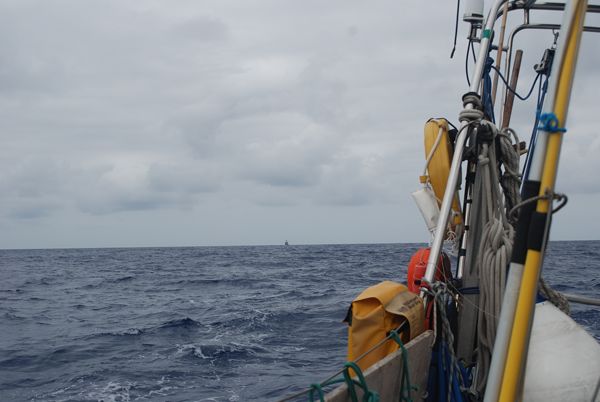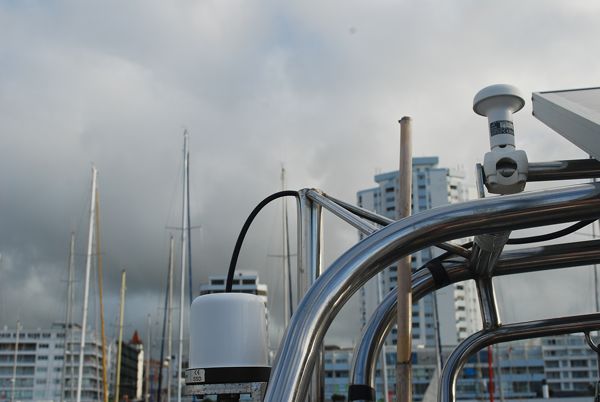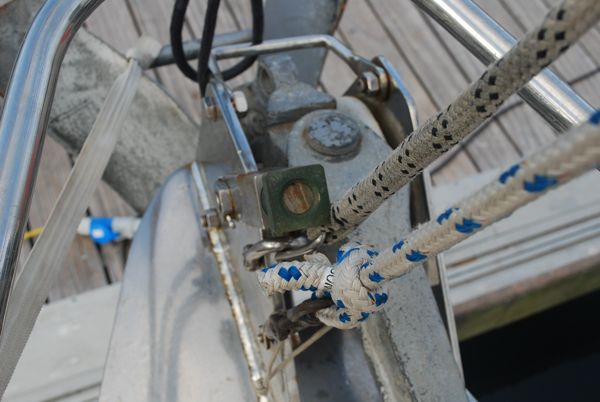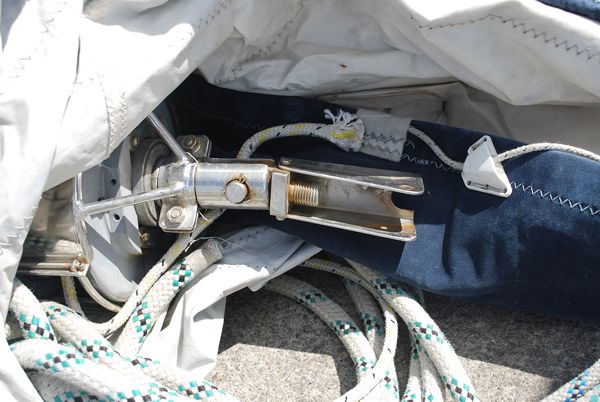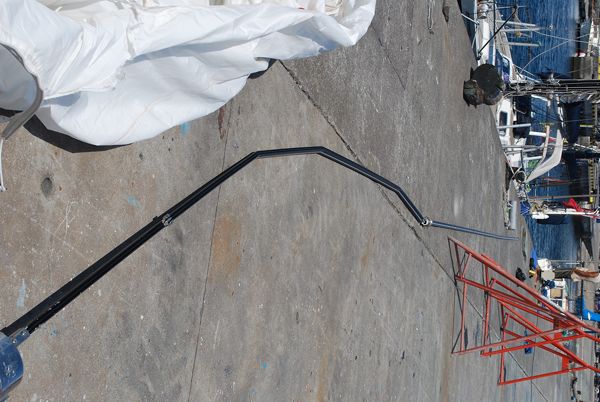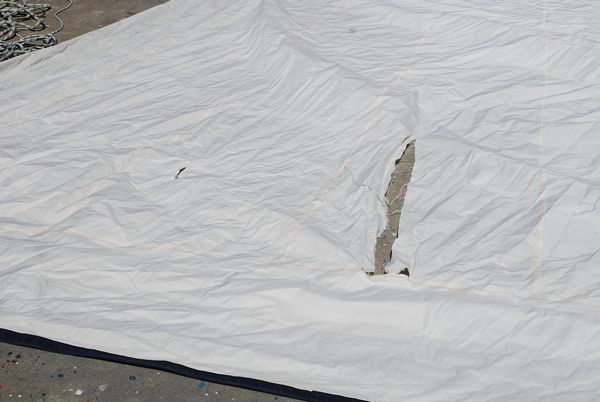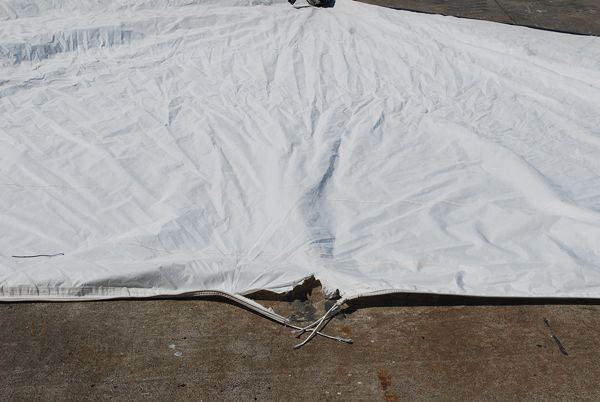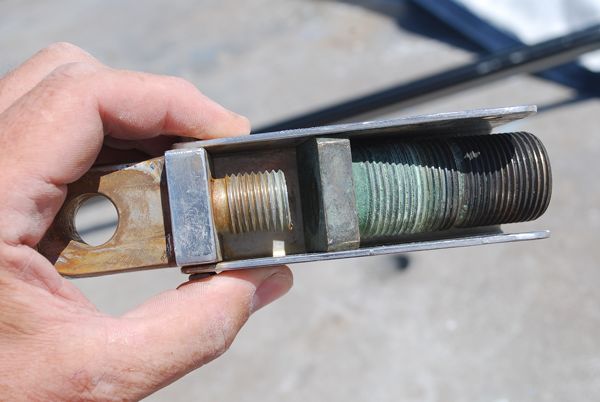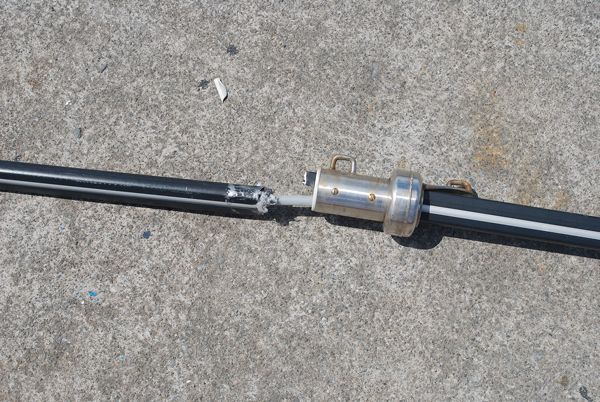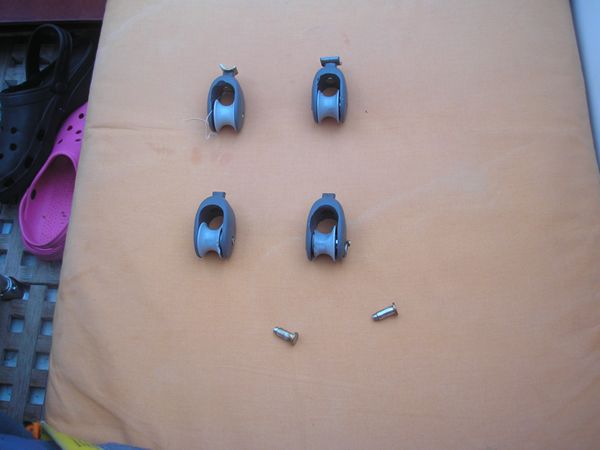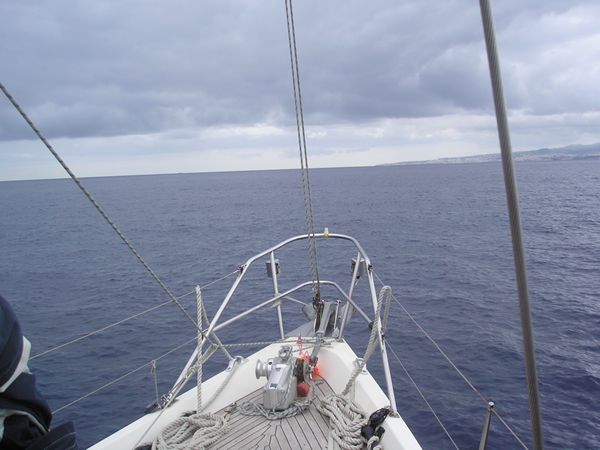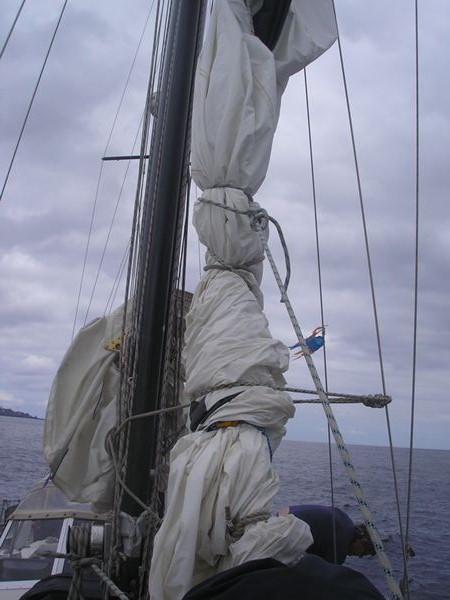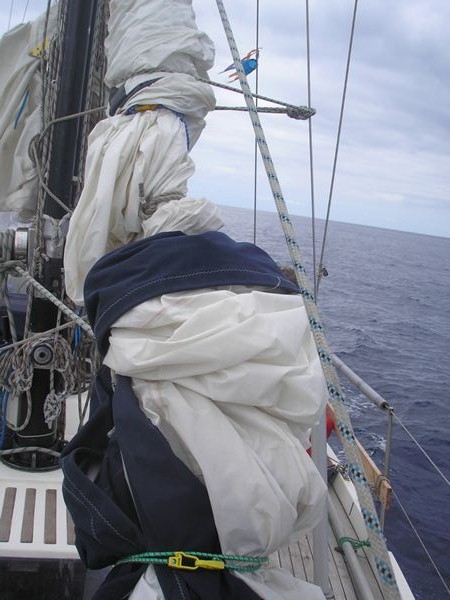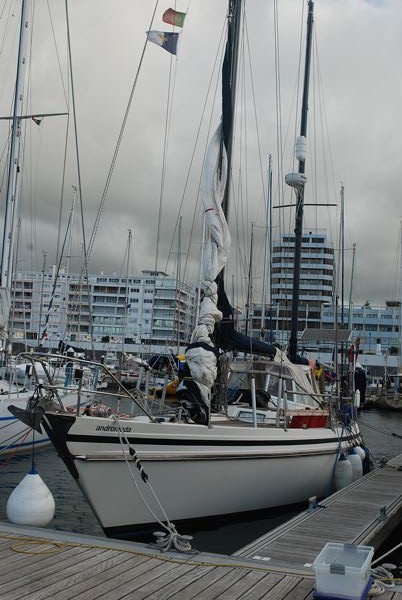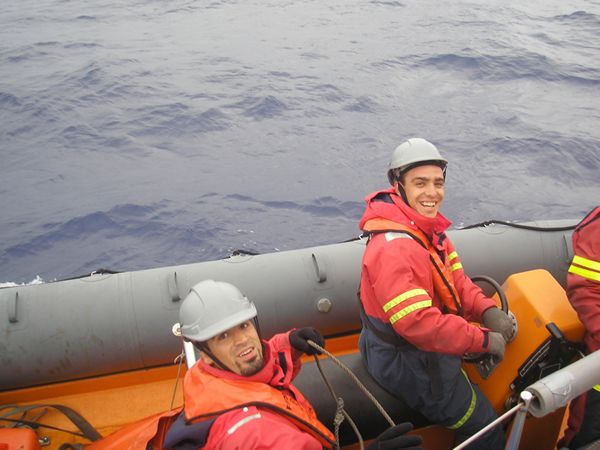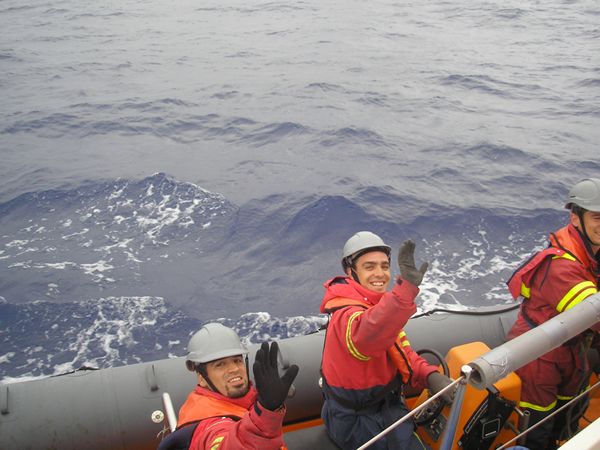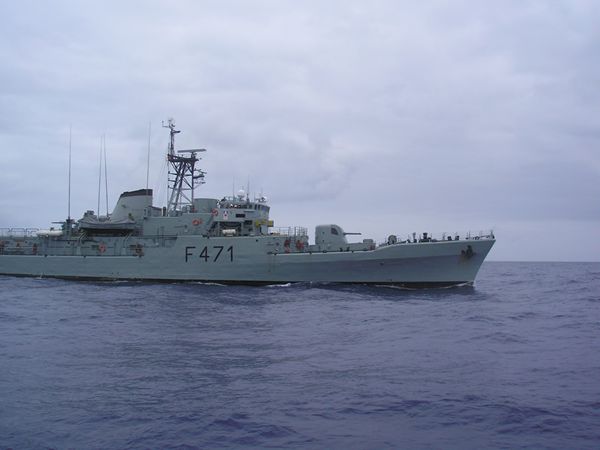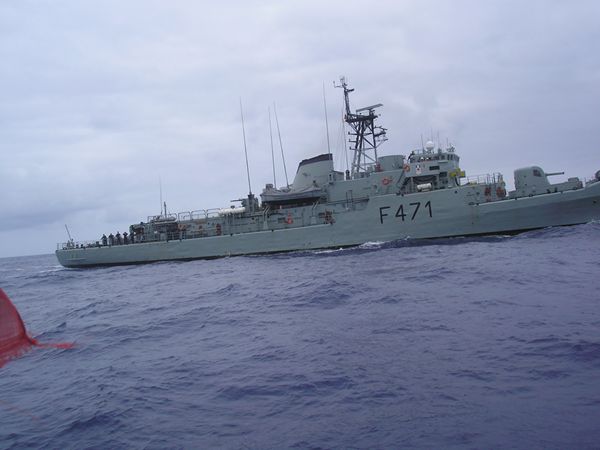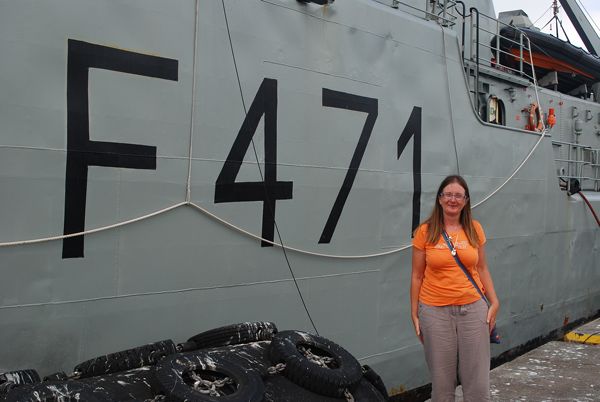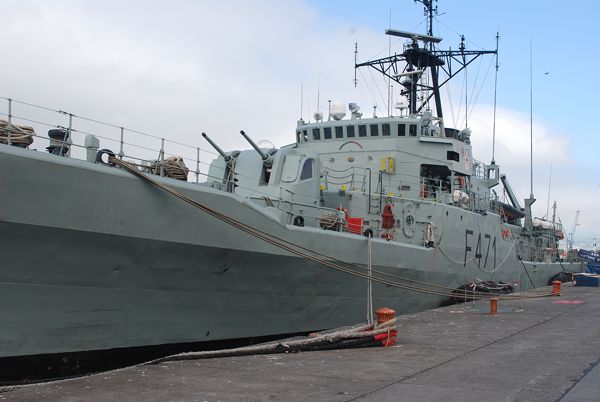There and back again to see how far it is.................

andromeda of plymouth
Susan and Andrew Wilson
Wed 4 Aug 2010 15:56
miles.
There is little that can prepare you for losing your forestay/roller
furler and the sheer challenge and effort of securing it while at sea in
21knot winds, other than wrestling with a 5 metre crocodile with attitude
and you on the menu – and this on a regular basis . This is the story
behind the blog posts....
We left Sao Miguel enroute for mainland Portugal for a trip of about 750
miles. We were sailing in 21knots of wind and making some 5 knots in a
short choppy sea with winds from the NNE. The sea state was unusual in
that it was very short and steep and not the long waves we had expected so
far from land. As a result we were sailing slower than we had anticipated.
As was our usual practice we reefed down for the night and had one reef
in the main and some 3 -4 rolls on the genoa.
At 5am on the morning of the fourth day there was a tremendous bang from
the forward end. Susan was steering the boat and I was preparing to take
over. As I sprinted out of the port side of the cockpit I could see the
forestay with genoa swinging way out over the starboard side guard rails.
It made for an awesome and frightening sight and the noise of the flapping
sail was dramatic. After what seemed an age(but probably only seconds) the
main blanketed enough of the genoa for it to swing to the starboard side
of the boat and both of us managed to take hold of the forestay and genoa
and bring it in board whilst Andromeda bobbed up and down on the waves –
thankfully we were fully dressed in our oilies and had our life jackets
and harnesses on and were attached. Grabbing any available line we roughly
tied the furler/genoa to stop it swinging back out again. The initial
thrust to the starboard side had also taken the furling line from its
guide rollers and this wrapped itself around the Aerogen blades and unit
which was then torn from its mount along with 120cm of stainless steel
mounting tube and disappeared into 2000 metres of the Atlantic Ocean (we
didn’t realise that this had happened at first until we looked up and saw
that the wind generator had gone). In addition 4 of the stanchions were
bent by the force of the furling line being dragged from the guide
rollers.
While Susan continued to tie and hold down the forestay and roller furler
I took the spare genoa halyard forward and secured it to the anchor
mounting, tightening it as much as much as possible and then took the
spinnaker halyard forward as well to help secure the mast. I dropped the
mainsail to reduce, as far as we could, any stress on the rig. We tried
to tie down as much of the flapping genoa as we could and get it under
some degree of control but quite a bit remained loose, flying about and
making a noise. As there were three or so rolls of the genoa wrapped
around the furler it was impossible to pull it down so gathering it in was
the only option. By this time the luff groove line had split in two places
adding even more difficulties to getting the sail down and had also
induced at least two tears in the fabric of the sail.
Once things were sorted to some degree we checked the sides for any
trailing lines, (this is where we noticed the absence of the wind
generator) started the engine and then contacted Falmouth MRCC on our
iridium (Satellite) phone to explain our situation and ask for their
advice. They took our details and following a short conversation we
decided to turn Andromeda around and headed back to Ponta Delgada, our
nearest landfall by 150 or so miles, on San Miguel, a distance of 293
miles away, which would have to be taken all under engine. We were
concerned whether we would have sufficient fuel although we carried 100
litres in cans in addition to the diesel in the main tank, so informed
Falmouth of this possible issue. This was going to be the longest ever
engine only passage we had undertaken so were very cautious and decided to
motor at 5knots to reduce as much as possible any rolling induced stress
on the rig and get the most miles out of our available fuel.
After about an hour or so it became fully light and we could see that
where we had tied down the forestay/genoa to the boom it was rubbing
against one of the main shrouds. We had to swing the genoa/forestay and
furling drum back forward and around the remaining shrouds otherwise we
would have even more problems. To do this meant untying everything already
tied down, then lifting the furler over the guard rails and back once
more forward of the shrouds, easier said than done given the sea state. It
took an hour for us to get the mess stabilised enough to avoid the worst
of the chaffe, although the top of the forestay did flap about to some
extent and occasionally bang the mast and spreaders, but there was nothing
else we could do and remain safely on the deck. It’s a really good job
that we have kept so much line on board (just in case) and never got rid
of any useable rope. We needed every bit of it as we gradually managed to
tie more and more of the loose sail down and ensure that none of it would
be pulled out by the wind and cause us even more problems – even the
bungee cords Susan bought from the Chinese shop in Lagos played a part.
Falmouth MRCC transferred control of our care to Ponta Delgada MRCC and
they arranged to contact us twice a day using the sat phone, to track our
progress. After the first 24 hours heading back to the Azores we emptied
our remaining 100 litres of fuel into the main tank -not an easy task in
the conditions- and estimated that we probably had just enough to get back
to Ponta Delgada if we scraped the barrel. However Ponta Delgada MRCC had
other plans. During that morning’s call at 10.30 am they asked us to
change course to rendezvous with a Portuguese warship that would transfer
some additional fuel to us. We changed course reluctantly as we would now
be heading slightly away from Ponta Delgada and headed southwest to the
rendezvous, due later that day sometime late afternoon/early evening. We
continued to make 5 knots and rolled a fair bit in the steep, short waves,
but it was manageable if not entirely comfortable. We maintained 4 hour
watches during the day and three hour watches during the night with our
Raymarine Autopilot – named Orion - performing magnificently.
At about 4.45 pm we could see a blur on the radar to the west and soon
after were hailed by the Portuguese corvette Antonio Enes, a search and
rescue vessel stationed in the Azores for several months. They announced
that they had us on visual and would be in our immediate vicinity in about
20 minutes and after scanning the horizon suddenly we could see them too.
After the previous couple of days with completely empty seas it was a real
pick up to see F471 and its crew approaching our position. Several
conversations ensued over the VHF radio as we were offered any help and
assistance we required and then a rib was lowered over the side. The rib
came swiftly towards us with a 3 man crew and very expertly transferred
100 litres of diesel in 5 cans to us. We thanked them profusely with waves
and smiles and a pack of 200 cigarettes (you all know we don’t smoke) and
they returned to their ship which then sailed passed Andromeda with what
seemed like the entire crew on deck waving and acknowledging us, and a
great weight had been taken off our minds as we now knew we would not be
stirring all the stuff at the bottom of the fuel tank in order to get to
Sao Miguel. We then reset our course for Ponta Delgada to the north-
west. The Captain like us, was puzzled as to why we had altered course to
the southwest but we explained it was at the request of the MRCC. Captain
Da Silva said they would be in Ponta Delgada over the weekend and we said
we would like to meet him and his crew to say thank you in person. Antonio
Enes then kept station for a while to make sure we were ok before resuming
their patrol.
During the night we only saw the lights of a couple of fishing boats miles
away but the following morning (Friday) at 8.30 the clouds lifted
momentarily and we could see our first glimpse of Sao Miguel. Another
great moment was when we passed the end of the island into the flattest
sea ever – it was truly a ‘mill pond’ and such a relief to the rolling we
had experienced until then. Andromeda kept on going at her steady 5 knot
rate but now we had a bit of a lift from the local current so were making
little more speed over the ground.
At 5pm on our third day of motoring we approached the marina and asked to
go straight to a berth and avoid the usual reception stop, which they were
happy to agree with under the circumstances. Andy and Lesley from Kodiak
were there to welcome us and caught our lines and helped us secure
Andromeda to the marina berth and we could finally turn off our
hardworking engine and relax. We thanked Andromeda and Orion for sterling
service and let Ponta Delgada MRCC know we had arrived so they could close
the incident. Lesley and Andy then helped put Andromeda to rights, sail
covers put on, cockpit cover erected, electricity sorted – whilst the
skipper went to clear us in. We then headed off for a meal to unwind a
bit and be able to sleep without it all racing around our brains.
The following day we washed down Andromeda from bow to stern and got rid
of the accumulated salt etc. After lunch Susan headed to a Lesley and
Andy’s hotel room (another story) for a long, long, long, hot bath. I
stayed on board to supposedly unwind (he didn’t follow instructions) and
later on in the afternoon two men approached Andromeda and asked if they
could come aboard. I asked why they should do so, distinctly nervous as
neither of them had any uniforms on nor identifying features and the
marina pontoons are supposed to be secure. The older man said I should let
them on as it’s not often they get to meet the people they help and
besides, I have his diesel on board. Sudden realisation – it was the
Captain of the Antonio Enes, Captain da Silva, accompanied by his
Executive Officer. They brought a bottle of Port and a picture of the
Antonio Enes as a memento of the rendezvous – I was absolutely blown away
with the kindness of this gesture. We arranged to go and visit the NRP
Antonio Enes the following day. As you might suppose Susan was really
miffed to have missed their visit even though by now she was glowing from
her really hot soak – and immediately made plans for the following day.
Sunday afternoon after another busy morning we walked around the harbour
to where F471 was moored and presented ourselves at the passerelle. The
young man on watch contacted the officer on duty and with minutes various
members of the crew had come and greeted us aboard and they appointed
their best English speaker as our guide. We had a really great time seeing
all aspects of the corvette from the flying bridge/bridge down to the
engines (2 engines of 6000 hp each– end to end probably longer than
Andromeda). The crew were all keen to meet us and we were taken to the
wardroom and given tea and had a long chat with the XO and returned their
kind gesture with a bottle of whisky for the wardroom and a picture of
Andromeda. Captain da Silva briefly joined us and told us that originally
they had thought they might knock on our hull at 2 am on Saturday morning
but decided to let us sleep (can you imagine our reaction) – they have a
wicked sense of humour.
Thankfully we only had bruises and the odd sprain from this incident – we
are acutely aware that it could have been so very different and we could
have lost the rig and potentially Andromeda. We are much older and wiser
as a result but with renewed faith in our trusty boat – she looked after
us so well. We also have a huge amount of respect and gratitude to the
Search and Rescue organisation in this part of the world particularly, the
Captain, XO and crew of F471 NRP Antonio Enes. When a friendly face was
needed they were there. Many thanks also go to Pedro from the MRCC team
who was monitoring and co-ordinating our return, we were grateful for his
regular calls and he has asked to stay in touch via facebook.
We are now concentrating on organising all necessary repairs and
replacement parts for Andromeda and feel we will be here for at least
another 4 weeks – it’s just as well that we left reluctantly in the first
place, we can now enjoy some more of this lovely island and its lovely
people.
More in due course
Susan and Andrew
s/v Andromeda
